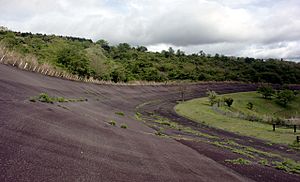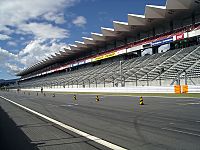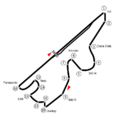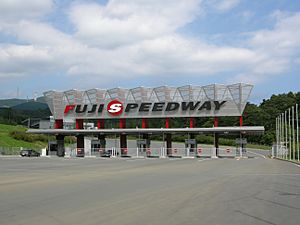Fuji Speedway facts for kids
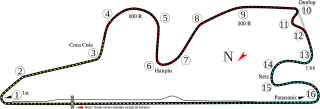
Grand Prix Circuit (2005–present)
|
|
| Location | Oyama, Suntō District, Shizuoka, Japan |
|---|---|
| Time zone | UTC+09:00 |
| Coordinates | 35°22′18″N 138°55′36″E / 35.37167°N 138.92667°E |
| Capacity | 110,000 |
| FIA Grade | 1 |
| Owner | Toyota (2000–present) Mitsubishi Estate (1965–2000) |
| Opened | December 1965 Re-opened: April 2005 |
| Closed | September 2003 |
| Major events | Current: FIA WEC 6 Hours of Fuji (2012–2019, 2022–present) GT World Challenge Asia (2017–2019, 2022–present) Super GT (1993–2003, 2005–present) Super Formula (1973, 1975–1979, 1982–2003, 2005–present) Lamborghini Super Trofeo Asia (2012–2019, 2023–present) Former: Formula One Japanese Grand Prix (1976–1977, 2007–2008) Grand Prix motorcycle racing Japanese motorcycle Grand Prix (1966–1967) Asian Le Mans Series 4 Hours of Fuji (2013–2018) World Sportscar Championship (1982–1988) |
| 4th and current configuration (2005–present) | |
| Length | 4.563 km (2.835 mi) |
| Turns | 16 |
| Race lap record | 1:18.426 ( |
| 3rd configuration (September 1987–2003) | |
| Length | 4.400/4.470 km (2.734/2.777 mi) |
| Turns | 12 |
| Race lap record | 1:17.025 ( |
| 2nd configuration (1975–August 1987) | |
| Length | 4.359/4.410/4.441 km (2.709/2.740/2.759 mi) |
| Turns | 8 (10 Turns from 1984 to August 1987) |
| Race lap record | 1:14.300 ( |
| Original Circuit (1965–1974) | |
| Length | 5.999 km (3.728 mi) |
| Turns | 15 |
| Race lap record | 1:32.570 ( |
Fuji Speedway (富士スピードウェイ, Fuji Supīdowei) is a famous motorsport race track located near Mount Fuji in Japan. It was built in the early 1960s. For many years, it hosted important races like the FIA World Sportscar Championship.
Toyota bought Fuji Speedway in 2000. The track then hosted the Formula One 2007 Japanese Grand Prix. This was a big return after almost 30 years! The Japanese Grand Prix later moved back to the Suzuka Circuit. Today, Fuji Speedway still hosts exciting races like the Super GT Fuji 500 km.
The track is known for having one of the longest straight sections in motorsport. It is about 1.475 kilometers (0.917 miles) long. The track has a special license from the FIA, which means it's approved for top-level races.
Contents
History of Fuji Speedway
Building the Track: 1963–1979
Fuji Speedway started as "Japan NASCAR Corporation" in 1963. The first plan was to build a track for NASCAR-style races. It was meant to be a 4-kilometer (2.5-mile) track with banked turns. But there wasn't enough money to finish it. Only one banked turn was completed.
Mitsubishi Estate took over the project in 1965. They changed the design to a regular road course. The track opened in December 1965. The wide banked turn, called "Daiichi," was quite dangerous. It caused many serious accidents.
In 1966 and 1967, Fuji Speedway hosted the Japanese motorcycle Grand Prix. This was a big event for motorcycle racing. The track also held a special Indy Car race in 1966.
After a very serious accident in 1974, a new part of the track was built. This made the course safer. The new track was 4.359 kilometers (2.709 miles) long. It removed some of the fast, dangerous corners.
The speedway brought the first Formula One race to Japan in 1976. It was a very exciting race where James Hunt won the championship. Mario Andretti won the race itself. In 1977, another crash happened, which led to Formula One leaving Fuji Speedway. When F1 returned to Japan years later, it went to Suzuka Circuit instead.
National Racing Era: 1980–2000
Fuji Speedway remained a popular place for sports car racing. The FIA World Sportscar Championship visited the track from 1982 to 1988. It was also used for many national races in Japan. To make the track safer, two chicanes (slow corners) were added. Even with these changes, the long 1.5-kilometer (0.93-mile) straight remained a key feature.
The long straight was also used for drag racing. Special events were held there in 1989 and 1993. Local drag races are still common on the circuit.
In 2000, Toyota bought most of the track from Mitsubishi Estate. This was part of Toyota's plans for future motor racing.
In 1998, there was a multi-car crash during a parade lap before a JGTC race. This happened because the safety car slowed down in heavy rain. Some drivers were injured in the accident.
Modern Renovations: 2001–Present
In 2003, the circuit closed for a big redesign. A famous track designer, Hermann Tilke, created the new layout. The track reopened on April 10, 2005. It hosted its first Formula One race in 29 years in 2007. This race was also held in heavy rain, and Lewis Hamilton won.
Since 2003, Fuji Speedway has hosted the Nismo Festival. This event celebrates historic Nissan race cars. Toyota also has its own historic event called the Toyota Motorsports Festival. Near the circuit, there is a special drifting course. It was designed by "Drift King" Keiichi Tsuchiya. There is also a Toyota Safety Education Center and a mini circuit.
The track is usually run in one direction. But for the D1 Grand Prix drifting event, it's run in reverse. This is because the new layout made entry speeds lower for drifting. Most of the old banked section of the track was removed during the 2003 renovations. Only a small part of it remains today.
Fuji Speedway was also chosen to host the finish of the road cycling races for the 2020 Summer Olympics. These games were held in 2021 due to the global pandemic.
Olympic Cycling Events: 2020 Summer Olympics
During the 2020 Summer Olympics (held in 2021), Fuji Speedway was the finish line for several cycling races:
- Men's individual road race: On July 24, 2021, Richard Carapaz (Ecuador) won gold. Wout van Aert (Belgium) won silver, and Tadej Pogačar (Slovenia) won bronze.
- Women's individual road race: On July 25, 2021, Anna Kiesenhofer (Austria) won gold. Annemiek van Vleuten (Netherlands) won silver, and Elisa Longo Borghini (Italy) won bronze.
- Women's road time trial: On July 28, 2021, Annemiek van Vleuten (Netherlands) won gold. Marlen Reusser (Switzerland) won silver, and Anna van der Breggen (Netherlands) won bronze.
- Men's road time trial: On July 28, 2021, Primož Roglič (Slovenia) won gold. Tom Dumoulin (Netherlands) won silver, and Rohan Dennis (Australia) won bronze.
Fuji Motorsports Forest: 2022 and Beyond
In April 2022, Toyota announced a new project called "Fuji Motorsports Forest." This project aims to redevelop the area around Fuji Speedway. It includes building the Fuji Speedway Hotel, which is operated by Hyatt. The hotel also features the Fuji Motorsports Museum. Both opened in October 2022.
Exciting Events at Fuji Speedway
Fuji Speedway hosts many different types of races and events throughout the year.
- Current Events
- March: Porsche Carrera Cup Japan
- May: Super GT Fuji 500 km Race, F4 Japanese Championship
- June: Super Taikyu Fuji 24 Hours, Ferrari Challenge Japan Ferrari Racing Days, Lamborghini Super Trofeo Asia, Formula Regional Japanese Championship
- July: GT World Challenge Asia, Super Formula Championship, Ferrari Challenge Japan, Japan Cup Series, Porsche Carrera Cup Japan
- August: Super GT, F4 Japanese Championship
- September: FIA World Endurance Championship 6 Hours of Fuji, Porsche Carrera Cup Japan, Super Formula Lights, Formula Regional Japanese Championship
- October: Super Formula Championship
- November: Super Taikyu S-Tai Final
- Future Events
- Porsche Carrera Cup Asia (expected in 2026)
- Past Events
- 2020 Summer Olympics Cycling at the 2020 Summer Olympics (2021)
- Asian Le Mans Series 4 Hours of Fuji (2013–2018)
- Audi R8 LMS Cup (2015)
- Ferrari Challenge Asia-Pacific (2014–2019, 2022)
- Formula One Japanese Grand Prix (1976–1977, 2007–2008)
- Fuji Grand Champion Series (1971–1989)
- Grand Prix motorcycle racing Japanese motorcycle Grand Prix (1966–1967)
- World Sportscar Championship All Japan Fuji 1000 Kilometres (1982–1988)
Track Layout Changes Over Time
Fastest Laps at Fuji Speedway

Here are some of the fastest official race lap records at Fuji Speedway:
| Category | Record | Driver | Car | Date |
|---|---|---|---|---|
| Current Track Layout: 4.549 km (2005–Present) | ||||
| Formula One | 1:18.426 | Ferrari F2008 | October 12, 2008 | |
| Super Formula | 1:21.391 | Dallara SF19 | December 20, 2020 | |
| LMP1 | 1:24.645 | Audi R18 | October 16, 2016 | |
| Super GT (GT500) | 1:28.441 | Toyota GR Supra GT500 | August 3, 2025 | |
| LMH | 1:30.735 | Toyota GR010 Hybrid | September 11, 2022 | |
| Formula 4 | 1:45.160 | Dome F110 | May 3, 2017 | |
| Older Track Layout: 4.400/4.470 km (September 1987 – 2004) | ||||
| Formula 3000 | 1:17.025 | Lola T93/50 | April 10, 1994 | |
| Group C | 1:17.574 | Nissan R92CP | May 4, 1992 | |
| JGTC (GT500) | 1:25.134 | Toyota Supra (JZA80) | July 28, 2002 | |
| Original Track Layout: 4.359/4.410/4.441 km (1966–August 1987) | ||||
| Formula One | 1:14.300 | Wolf WR1 | October 22, 1977 | |
| Formula Two | 1:18.310 | March 842 | April 15, 1984 | |
| First Track Layout: 5.999 km (1965–1974) | ||||
| Formula 2000 | 1:32.570 | March 722 | May 3, 1973 | |
Corners of the Track
This is a list of the twelve corners on the current Fuji Speedway track, used since 2005. Some corners have Japanese names or names from sponsors. Others are named after their radius (how sharp the curve is) in meters.
- TGR Corner (27R)
- 75R
- Coca-Cola Corner (80R)
- Toyopet (100R)
- Advan Corner (30R)
- 120R
- 300R
- Dunlop Corner (15R)
- 30R
- 45R
- GR Supra Corner (25R)
- Panasonic Corner (12R)
The Dunlop corner changes depending on the track setup. In the full setup, it's a tight right turn followed by a quick left-right. In the GT course, it's a medium-speed right turn that skips turns 11 and 12.
See also
 In Spanish: Fuji Speedway para niños
In Spanish: Fuji Speedway para niños



